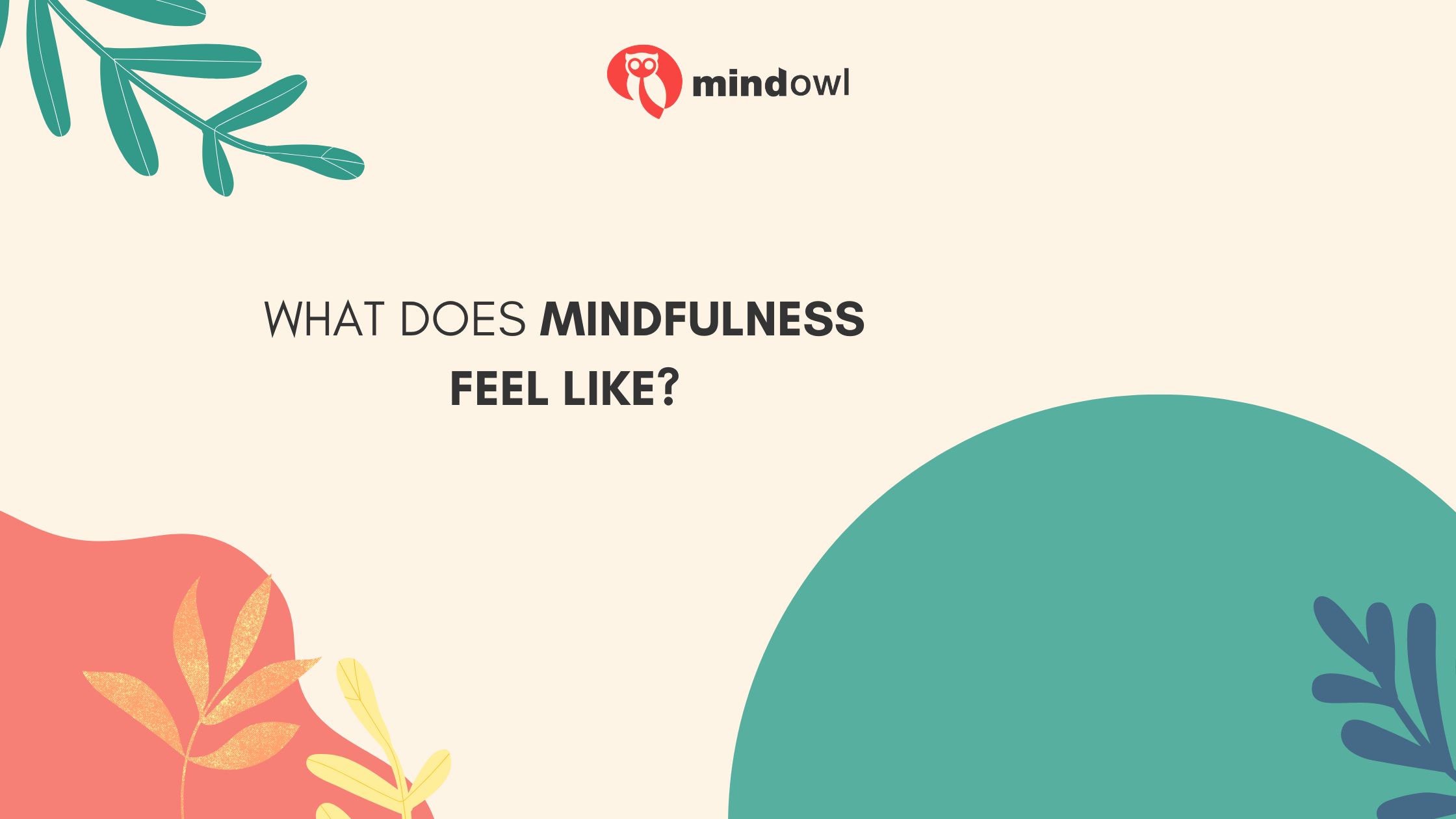
In a world that’s constantly buzzing with activity, the quest for mental peace can feel like searching for a needle in a haystack. Mindfulness is scientifically proven to enhance focus and calmness.
This article will explore the feeling of mindfulness and guide you towards achieving it in your daily life. Discover tranquillity within.
Key Takeaways
- Mindfulness is about noticing thoughts and feelings without judgement, not constant happiness. It helps you see the present clearly.
- Regular mindfulness can reduce stress, improve mental health, and make you more aware of yourself.
- You don’t need quiet or special tools to practice mindfulness; it fits into everyday activities like walking or eating.
Mindfulness: Definition and Purpose

Mindfulness means paying close attention to what’s happening right now. You notice your thoughts, feelings, and the world around you without deciding if they’re good or bad. It’s like a spotlight for your mind but one that doesn’t judge.
This can help you accept how things are and be fully in each moment.
The purpose of mindfulness is big. It aims to improve how we feel inside and deal with life better. By being mindful, we can reduce stress and become happier and healthier. People use it to find calmness, focus on tasks better, understand themselves more, and enjoy life’s little details.
It comes from old meditation practices but now helps many people in their everyday lives.
How Mindfulness Works

Mindfulness works by allowing individuals to observe their thoughts and emotions without judgment, helping them gain perspective, and focusing on the present moment. This practice can lead to a sense of calmness, heightened awareness, a detachment from negative thoughts and emotions, increased self-awareness, and improved control over reactions.
Observing thoughts and emotions without judgement
Practicing mindfulness means we watch our thoughts and feelings like clouds drifting in the sky. There’s no need to judge or get lost in them; just notice they’re there. It’s like being a bird high above, seeing everything below but not getting caught in the branches.
This practice helps us step back from what we feel and think. We can see our mind’s chatter without it pulling us around. This gives us peace and helps us understand ourselves better.
When life gets busy, this skill keeps us steady and less likely to become overly reactive or overwhelmed by what’s going on around us.
Taking a step back and gaining perspective
After you observe your thoughts without judging them, the next step is to get some distance from them. This means looking at your thoughts as if they are not a part of you but just things passing by.
Imagine stepping back in your mind and watching your worries like clouds moving across the sky. This helps you see that you’re more than what you think or feel.
Mindfulness gives you space to understand that emotions don’t have to control what you do. You learn that feelings come and go, and this view can make it easier for you to choose how to act.
The practice lets you see patterns in how emotions sway your choices and actions. Over time, gaining perspective through mindfulness leads to better decisions because it brings calmness when making tough calls.
Focusing on the present moment
Mindfulness is about paying attention to the present. This means looking at what’s happening right now, not in the past or future. When you practice mindfulness, you might notice things like the feel of your breath or the sounds around you.
It helps you enjoy each moment and may even make it seem like time is moving slower.
To do this, you don’t need any special tools or a quiet room; just focus on now. You can be mindful while walking, eating, or even working. Just bring your mind back when it wanders off.
Now let’s talk about what mindfulness can feel like and how it changes things inside us.
What Mindfulness Can Feel Like
Mindfulness can feel like a sense of calmness and relaxation, heightened awareness and clarity, detachment from negative thoughts and emotions, increased sense of control, and improved self-awareness.
Interested in learning more about how mindfulness can benefit you? Keep reading to discover real-life experiences and common misconceptions about mindfulness.
A sense of calmness and relaxation
Feeling calm and relaxed is a key part of mindfulness. Practising mindfulness can help reduce pain, making you feel more at ease. It trains your brain to be less reactive so you can make clearer choices.
This feeling is like having a quiet space inside, even if the world around you is loud or busy.
Imagine being by a peaceful lake instead of caught in a storm. Mindfulness meditation creates changes in the brain that improve mental and physical health. These changes lead to this peace and balance within yourself, helping with both feelings and overall well-being.
– Heightened awareness and clarity
Heightened awareness and clarity
Mindfulness brings your senses to life. You start to notice small details around you, like the way light plays on surfaces or the distant hum of city life. This clarity helps you see things as they really are, not just how your busy mind might tell you they are.
Mindfulness practice sharpens your focus. It’s like cleaning a window after a storm; suddenly everything outside looks bright and clear.
This sharper focus can help in daily life too. Perhaps you’re talking with a friend and truly listen to their words without thinking about what to say next or getting lost in other thoughts.
With mindfulness, it’s easier to spot when your feelings might be swaying your choices, allowing for better decisions that align with what’s important in life. By paying attention on purpose, moment by moment, mindfulness peels away layers of confusion and lets you connect more deeply with yourself and others.
A detachment from negative thoughts and emotions
With a clear mind, we can begin to step away from the grip of negative thoughts and emotions. This is part of what mindfulness feels like – you find yourself able to leave behind worries and fears without trying to push them away or fix them.
It’s like watching clouds drift by in the sky; they’re there, but you don’t have to hold onto them. Detached mindfulness means that your mind doesn’t get tangled up with any bad feelings.
This state of being doesn’t force us to change how we feel. Instead, it teaches us that we don’t need to fear our own thoughts or let them control us. Studies show that this kind of mindfulness helps stop worry and improves problem-solving skills because it lets us deal with issues more clearly.
Being mindful creates a space where we can face life’s challenges calmly and with confidence, knowing that negative emotions do not define our whole experience.
Increased sense of control
As a result of experiencing a detachment from negative thoughts and emotions, mindfulness can lead to an increased sense of control. Studies have shown that practicing mindfulness can help individuals gain a better understanding of their emotions and thought patterns, allowing them to respond more effectively to challenging situations.
This heightened awareness can empower individuals to make conscious choices rather than reacting impulsively, leading to a greater sense of control over their actions and emotional responses.
Moreover, by cultivating mindfulness, people may develop the ability to let go of unproductive or harmful thoughts, enhancing their overall well-being and resilience in the face of adversity.
Furthermore, research has indicated that mindfulness is linked with improved self-regulation and emotional stability. By becoming more attuned to their inner experiences through mindful practice, individuals are better equipped to manage stressors and navigate difficult circumstances with composure.
This enhanced capacity for self-regulation also extends into various aspects of life, enabling individuals to approach challenges with a clearer mindset and make decisions aligned with their values and long-term goals.
Improved self-awareness
As mindfulness fosters an increased sense of control, it also nurtures improved self-awareness. Research indicates that mindfulness meditation can enhance self-awareness by boosting mindfulness and reducing negative emotions.
When individuals engage in regular mindfulness practice, they often experience a heightened awareness of their thoughts, emotions, and bodily sensations. This heightened awareness enables them to better understand their own mental and emotional processes, leading to a clearer perception of oneself and one’s reactions to various experiences.
Through this process, individuals may develop a deeper understanding of their strengths and areas for growth, ultimately contributing to an enhanced sense of self-awareness.
Furthermore, the practice of mindfulness has been associated with improvements in self-control and mental clarity. By observing thoughts without judgment and remaining present in the moment, individuals can gain insight into their habitual patterns of thinking and behaving.
Real Life Experiences of Mindfulness
Individuals who have incorporated mindfulness into their daily lives have reported reduced stress levels, improved mental clarity, and a greater sense of overall wellbeing. To learn more about the real-life experiences of mindfulness, keep reading and discover how it can positively impact your life.
Examples of incorporating mindfulness in daily life
Incorporating mindfulness into daily life can be achieved through various practices that cultivate present-moment awareness and reduce stress. Examples include:
- Practicing gratitude: Focusing on positive aspects of life in the present moment, such as appreciating nature or expressing thanks to others, can enhance mindfulness.
- Mindful eating: Paying attention to the sensory experiences while consuming food, such as textures, flavors, and smells, promotes mindfulness during meals.
- Mindful walking: Taking time to notice the surroundings, feeling the ground beneath each step, and being aware of the body’s movements contribute to mindfulness in motion.
- Mindful communication: Actively listening without judgment, being present in conversations, and speaking thoughtfully encourage mindful interactions with others.
- Mindful technology use: Setting aside designated times for digital detox or using apps that promote mindfulness can help in balancing technology consumption.
- Mindful productivity: Incorporating short mindfulness breaks during work hours or engaging in mindful breathing exercises before tackling tasks can improve focus and reduce stress levels.
- Mindful self-care: Engaging in activities like yoga, deep breathing exercises, or journaling to reconnect with oneself and foster a sense of calmness amid daily responsibilities.
Benefits experienced by individuals who practise mindfulness
Practicing mindfulness can lead to various benefits, including:
- Reduced Stress: Mindfulness has been linked to lower stress levels through its ability to promote relaxation and calmness, as supported by research showing its effectiveness in stress reduction.
- Improved Mental Health: Individuals who practice mindfulness often report decreased symptoms of anxiety and depression, attributed to the practice’s ability to cultivate a more positive outlook and attenuate negative emotions.
- Enhanced Cognitive Function: Regular mindfulness practice has been associated with increased clarity in thinking and perception, leading to improved memory and cognitive abilities.
- Better Physical Health: Mindfulness has been shown to have a positive impact on physical health, with benefits such as lower blood pressure and improved sleep quality documented by scientific studies.
- Increased Happiness: Research supports the notion that mindfulness can contribute to overall happiness in life, as individuals experience a greater sense of internal stillness and contentment through regular practice.
- Heightened Self-Awareness: Practicing mindfulness often leads to enhanced self-awareness, allowing individuals to become more attuned to their thoughts, feelings, and bodily sensations, fostering a deeper understanding of oneself.
- Enhanced Emotional Regulation: Mindfulness practice enables individuals to better manage their emotions, leading to fewer temper flares and an increased ability to respond rather than react impulsively in challenging situations.
- Improved Relationships: Mindfulness can support healthier relationships by promoting better communication, empathy, and understanding between individuals in various social settings.
Common Misconceptions About Mindfulness
Many people believe that mindfulness is a constant state of happiness, but in reality, it is about observing and accepting all emotions without judgement. To learn more about the common misconceptions surrounding mindfulness, keep reading to gain a deeper understanding of this practice.
Expectations vs. reality
While some may expect mindfulness to bring constant happiness, the reality is that it’s about being aware of our experiences without judgment. Mindfulness doesn’t guarantee a state of bliss; instead, it allows us to acknowledge all emotions and thoughts in a kind and non-judgmental way.
This includes facing feelings of frustration or restlessness during meditation, which are part of the process rather than signs of failure.
Moreover, the common belief that meditation aims to clear the mind completely is not accurate. Instead, mindfulness involves observing one’s thoughts and emotions with kindness and compassion.
Addressing the idea of mindfulness as a constant state of happiness
It’s important to clarify that mindfulness doesn’t promise a constant state of happiness. Our sense of contentment can fluctuate, challenging the idea of mindfulness as an eternal source of joy.
Mindfulness encourages accepting and being aware of the present moment, regardless of the emotions it brings. It’s not about ensuring constant bliss but about acknowledging and understanding our experiences.
Mindfulness is not a guarantee for feeling happy or at peace all the time. The practice involves being present in each moment, embracing whatever emotions arise without judgment or attachment.
Conclusion
In conclusion, mindfulness can feel like a calm and clear state of mind, allowing you to detach from negativity and gain control. Individuals who practice mindfulness often report heightened awareness and an improved sense of self.
This basic ability to be fully present in the moment can lead to positive changes in emotional and physical well-being. Incorporating mindfulness into daily life can help sharpen the mind and improve overall quality of life.
FAQs
1. What is mindfulness and how does it feel?
Mindfulness is being aware of your mind and body in the present moment. It feels like paying close attention to things like the breath going in and out or the way your feet touch the ground.
2. Do I need to meditate on a cushion or close my eyes to practice mindfulness?
No, you don’t need a meditation cushion, and it’s not necessary to close your eyes. You can practice mindfulness anywhere by simply noticing what’s around you and how you feel.
3. Can practicing mindfulness help me feel calmer?
Yes! Mindfulness helps you become more aware of each moment which can make you feel calmer as you learn to bring your attention back when your mind wanders.
4. Is mindfulness difficult to do?
Mindfulness isn’t necessarily easy because our minds wander a lot, but with practice, getting started with simple exercises like focusing on breathing or doing a body scan can help reduce stress.
5. Will I see results quickly if I start practicing mindfulness?
It may take some time before you notice big changes, as benefits of mindfulness build up slowly with regular practice even without trying for quick results.
6. Does being mindful mean sitting still all the time?
No, there are many ways to be mindful including mindful movement where you pay attention to how your body feels while moving; this could be walking or stretching too.
MindOwl Founder – My own struggles in life have led me to this path of understanding the human condition. I graduated with a bachelor’s degree in philosophy before completing a master’s degree in psychology at Regent’s University London. I then completed a postgraduate diploma in philosophical counselling before being trained in ACT (Acceptance and commitment therapy).
I’ve spent the last eight years studying the encounter of meditative practices with modern psychology.

